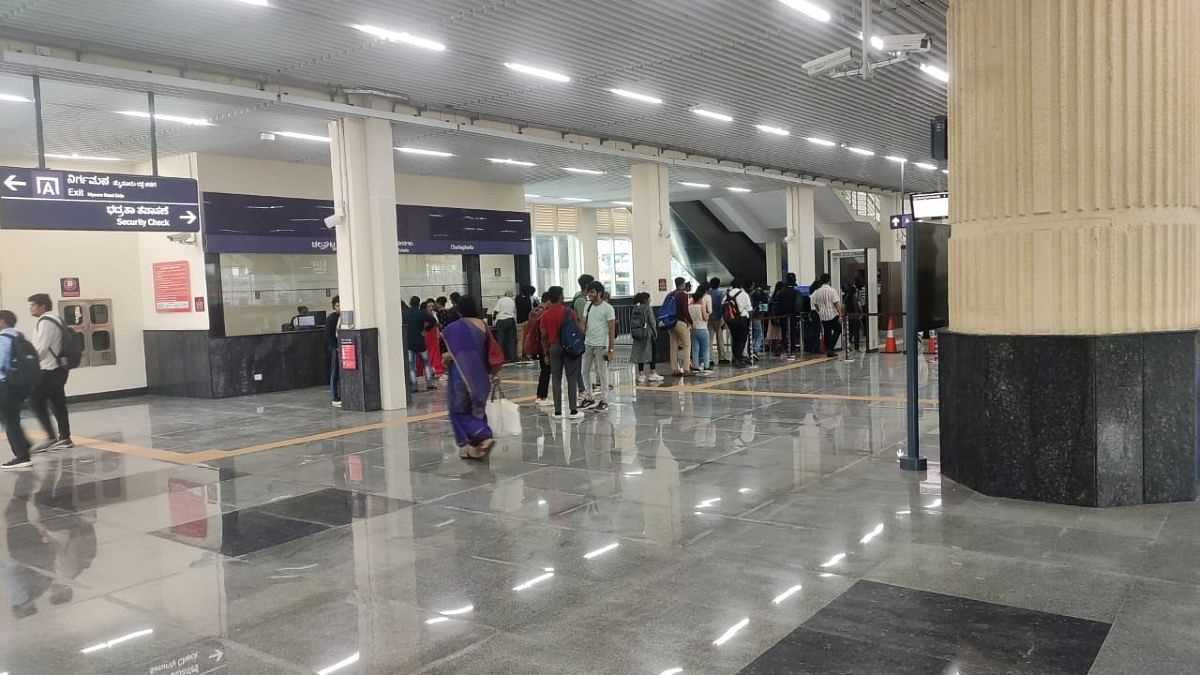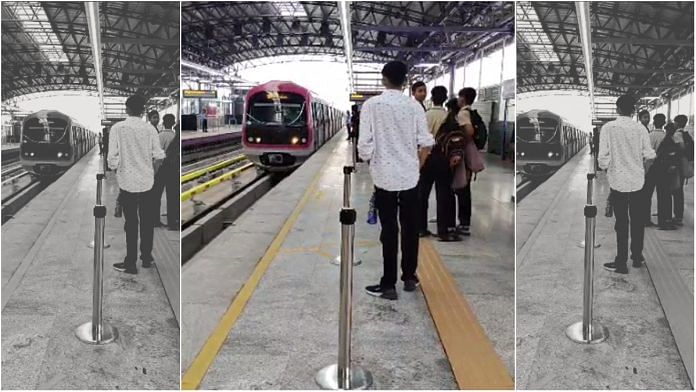Bengaluru: At 5 am Monday, the first metro rail from Whitefield’s Kadugodi station in the far east of Bengaluru became operational with no grand event like a flagging-off ceremony, as has been the norm before.
Though the Purple Line — some of the most important technology companies and large residential localities in the east to the western part of India’s IT capital — has been operational for a while now, a 2.10 km stretch from Krishnarajapuram to Baiyappanahalli, and another 2.05 km stretch from beyond Kengeri to Challaghatta became functional Monday.
This new line is expected to make it easier for commuters who travel to Whitefield, a tech hub, for work. An end-to-end journey on this line would cost Rs 60, significantly lower than what it would cost if one used a private vehicle or took a cab. For example, on Monday evening, a ride between Kadugodi and Challaghatta cost Rs 1109 in a cab and Rs 909 in an auto on Uber. The estimated time taken in a car would be just under two hours, while a metro ride would cost half the time.
It remains to be seen whether this new line will help decongest Bengaluru. While the metro helps the Bengaluru commuter bypass congested traffic and dusty, pothole-riddled roads, it has not lived up to its potential largely due to how the entire project was planned, leaving out most parts of the city.
Bengaluru got roasted for its never-ending traffic nightmare by South African comedian Trevor Noah earlier this month, days after he cancelled two shows scheduled to be held in the city “due to technical issues”. In a video uploaded on YouTube, he said he was stuck in a car for two hours and missed his sound check.
“With the opening of these two vital sections, the complete East–West corridor, the Purple Line from Whitefield (Kadugodi) to Challaghatta will be complete with a total length of 43.49 km and 37 metro stations,” a spokesperson for the Bengaluru Metro Rail Corporation Limited (BMRCL) told ThePrint Sunday evening.
The two stretches cost Rs 363.48 crore and Rs 167.97 crore respectively.
Momentous!
For the convenience of people, services on two stretches of Purple Line of #BengaluruMetro have been started without waiting for any VIP or elaborate opening ceremony to provide seamless connectivity on entire length from Challaghatta to Whitefield!#CitizenOverVIP pic.twitter.com/p9mkZrenSM— Hardeep Singh Puri (@HardeepSPuri) October 9, 2023
Good Morning, Bengaluru!
It’s so nice to see people send videos of Namma Metro #PurpleLine chugging along the whole stretch, while roads are choking with traffic underneath.
It’s an important reminder that the answer to traffic congestion is not building more roads, but… pic.twitter.com/yH2k5zdoJH
— Tejasvi Surya (@Tejasvi_Surya) October 9, 2023
With this line now running, the total length of Bengaluru’s metro rail network increased to 73.81 km from 69.66 km with 66 metro stations, the BMRCL said.
Metro rail is Bengaluru’s biggest public mass mobility investment, but the project has been delayed for various reasons, adding to the problem of growing traffic in the city.
Experts say that the longer it takes to implement mass mobility solutions, the problem of dependence on private transport increases, compounded by population growth.
Bengaluru’s car population jumped to 1.04 crore (till March 2022) from 50.33 lakh in 2011-12, according to transport department data. The city also has one of the worst drive times globally.
In 2019, Bengaluru was adjudged to have the worst traffic among 415 cities in 57 countries by Netherlands-based global provider of navigation, traffic and map products, TomTom.
Also Read: As Karnataka carpooling row continues, Bengaluru ready for disruptive fix to traffic woes
‘First and last mile connectivity key’
Metro services began in Bengaluru in October 2011 when a 6.7 km stretch between MG Road and Byappanahalli was inaugurated. But 13 years later, the operational lines span 73.18 km, which works up to just over 5.62 km of metro lines per year.
Bengaluru currently has two operational metro lines — Green and Purple. The daily ridership on both lines is estimated to be around 7.50 lakh, according to BMRCL. Bengaluru has a population of around 13 million.

Most public transport users continue to rely on buses while others depend on private transport like two-wheelers and cars.
The Siddaramaiah-led Congress government’s ‘Shakti’ scheme of free bus rides for women has been a huge success in rural parts of the state but has had little impact in urban centres like Bengaluru, barring perhaps the dependence on auto-rickshaws.
Large parts of the city continue to remain outside the operational or proposed metro lines, forcing dependence on private transport.
According to V Ravichandar, an expert on urban infrastructure, the metro’s success will depend on its ability to aggressively add feeder service buses to cater to the heavily congested tech-corridors like Outer Ring Road among others.
“Metro by itself is definitely a utility but this can be doubled if we can match it with feeder buses,” he told ThePrint.
He added that if there is no proper first and last mile connectivity, people are forced to look at private vehicles as an option for a portion of the trip or entirely. “You lose the battle if people have taken out a private vehicle.”
Bengaluru has long battled with traffic and crumbling infrastructure, forcing its residents to endure extreme hardships in their daily commute even though the city’s administrators spare no opportunity to highlight its monikers like ‘startup hub’ and ‘IT capital’ among others.
Deputy Chief Minister and in-charge of Bengaluru city DK Shivakumar has even proposed a 190 km underground tunnel road to decongest the city that is estimated to cost over Rs 50,000 crore.
One of the proposals in the Karnataka government’s ‘$1 trillion economy’ vision document is to try and impose a congestion tax in Bengaluru for all non-exempt vehicles to pay a certain fee as a revenue stream and not as a solution for traffic.
Blame game
Last month, videos and pictures of traffic gridlocks in the technology corridor went viral, triggering a blame game between the ruling Congress and opposition Bharatiya Janata Party (BJP).
“Bengaluru’s tech hub, ORR, faced an unprecedented traffic jam, trapping techies, office-goers, and school buses for almost 4 hours. The Baiyappanahalli-KR Pura metro link, could have eased this, but the state government’s inaction, despite CMRS approval, prolongs the suffering,” PC Mohan, the member of Parliament from Bengaluru Central, wrote on social media platform X.
Bengaluru's tech hub, ORR, faced an unprecedented traffic jam, trapping techies, office-goers, and school buses for almost 4 hours.
The Baiyappanahalli-KR Pura metro link, could have eased this, but the State Govt's inaction, despite CMRS approval, prolongs the suffering. pic.twitter.com/LJEelVPRIU
— P C Mohan (@PCMohanMP) September 27, 2023
Ironically, a large portion of the blame falls on the metro construction on the Outer Ring Road (ORR) that has shrunk road size to almost half and eaten up the dedicated bus lane.
Since then, the two national parties have taken turns to attack the other on the delays in operationalising the metro and decongesting the city.
Unplanned and unregulated expansion of Bengaluru has forced successive state governments to continue focussing their energies on its growth engine. Political parties blame each other for the problems faced by Bengaluru but have been unable to find solutions except offer expensive and unsustainable ideas that barely make it past the proposal phase.
“I had requested on the 5th of October, 2023 to the Government of India for the opening of two sections between KR Puram to Baiyappanahalli and from Kengeri to Challaghatta. The GoI has responded to inform that the above two sections will be formally dedicated to the nation by the Hon’ble Prime Minister and the Hon’ble Chief Minister of Karnataka within two weeks of time,” Shivakumar wrote on X Sunday.
He added: “In order to provide immediate convenience to the commuters in these two vital missing links of the East-West corridor of BMRCL, we have decided to make the above two sections operational from the 9th of October, 2023.”
(Edited by Gitanjali Das)
Also Read: Parking crisis is denting Brand Bengaluru. Now a top cop with a PhD is trying to save the day



